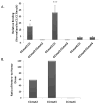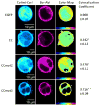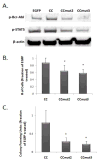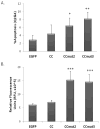Improved coiled-coil design enhances interaction with Bcr-Abl and induces apoptosis
- PMID: 22136227
- PMCID: PMC3313827
- DOI: 10.1021/mp200461s
Improved coiled-coil design enhances interaction with Bcr-Abl and induces apoptosis
Erratum in
-
Correction to "improved coiled-coil design enhances interaction with bcr-abl and induces apoptosis".Mol Pharm. 2012 May 7;9(5):1535. doi: 10.1021/mp300089a. Epub 2012 Mar 23. Mol Pharm. 2012. PMID: 22444272 Free PMC article. No abstract available.
Abstract
The oncoprotein Bcr-Abl drives aberrant downstream activity through trans-autophosphorylation of homo-oligomers in chronic myelogenous leukemia (CML).(1, 2) The formation of Bcr-Abl oligomers is achieved through the coiled-coil domain at the N-terminus of Bcr.(3, 4) We have previously reported a modified version of this coiled-coil domain, CCmut2, which exhibits disruption of Bcr-Abl oligomeric complexes and results in decreased proliferation of CML cells and induction of apoptosis.(5) A major contributing factor to these enhanced capabilities is the destabilization of the CCmut2 homodimers, increasing the availability to interact with and inhibit Bcr-Abl. Here, we included an additional mutation (K39E) that could in turn further destabilize the mutant homodimer. Incorporation of this modification into CCmut2 (C38A, S41R, L45D, E48R, Q60E) generated what we termed CCmut3, and resulted in further improvements in the binding properties with the wild-type coiled-coil domain representative of Bcr-Abl [corrected]. A separate construct containing one revert mutation, CCmut4, did not demonstrate improved oligomeric properties and indicated the importance of the L45D mutation. CCmut3 demonstrated improved oligomerization via a two-hybrid assay as well as through colocalization studies, in addition to showing similar biologic activity as CCmut2. The improved binding between CCmut3 and the Bcr-Abl coiled-coil may be used to redirect Bcr-Abl to alternative subcellular locations with interesting therapeutic implications.
Figures






Similar articles
-
Disruption of Bcr-Abl coiled coil oligomerization by design.J Biol Chem. 2011 Aug 5;286(31):27751-60. doi: 10.1074/jbc.M111.264903. Epub 2011 Jun 9. J Biol Chem. 2011. PMID: 21659527 Free PMC article.
-
Enhanced and selective killing of chronic myelogenous leukemia cells with an engineered BCR-ABL binding protein and imatinib.Mol Pharm. 2012 Nov 5;9(11):3318-29. doi: 10.1021/mp3003539. Epub 2012 Oct 12. Mol Pharm. 2012. PMID: 22957899 Free PMC article.
-
Changing the subcellular location of the oncoprotein Bcr-Abl using rationally designed capture motifs.Pharm Res. 2012 Apr;29(4):1098-109. doi: 10.1007/s11095-011-0654-8. Epub 2011 Dec 20. Pharm Res. 2012. PMID: 22183511 Free PMC article.
-
Molecular Modeling of Single- and Double-Hydrocarbon-Stapled Coiled-Coil Inhibitors against Bcr-Abl: Toward a Treatment Strategy for CML.J Phys Chem B. 2024 Jul 11;128(27):6476-6491. doi: 10.1021/acs.jpcb.4c02699. Epub 2024 Jul 1. J Phys Chem B. 2024. PMID: 38951498 Free PMC article.
-
Purification of TAT-CC-HA protein under native condition, and its transduction analysis and biological effects on BCR-ABL positive cells.Biomed Pharmacother. 2011 Jun;65(3):183-92. doi: 10.1016/j.biopha.2011.02.013. Epub 2011 May 20. Biomed Pharmacother. 2011. PMID: 21641753
Cited by
-
Resistant mutations in CML and Ph(+)ALL - role of ponatinib.Biologics. 2014 Oct 20;8:243-54. doi: 10.2147/BTT.S50734. eCollection 2014. Biologics. 2014. PMID: 25349473 Free PMC article. Review.
-
Selective targeting of c-Abl via a cryptic mitochondrial targeting signal activated by cellular redox status in leukemic and breast cancer cells.Pharm Res. 2012 Aug;29(8):2317-28. doi: 10.1007/s11095-012-0758-9. Epub 2012 May 2. Pharm Res. 2012. PMID: 22549737 Free PMC article.
-
Multidomain targeting of Bcr-Abl by disruption of oligomerization and tyrosine kinase inhibition: toward eradication of CML.Mol Pharm. 2013 Sep 3;10(9):3475-83. doi: 10.1021/mp400323c. Epub 2013 Aug 20. Mol Pharm. 2013. PMID: 23915432 Free PMC article.
-
Re-engineered p53 chimera with enhanced homo-oligomerization that maintains tumor suppressor activity.Mol Pharm. 2014 Jul 7;11(7):2442-52. doi: 10.1021/mp500202p. Epub 2014 May 29. Mol Pharm. 2014. PMID: 24836513 Free PMC article.
-
The DNA binding domain of p53 is sufficient to trigger a potent apoptotic response at the mitochondria.Mol Pharm. 2013 Oct 7;10(10):3592-602. doi: 10.1021/mp400380s. Epub 2013 Sep 6. Mol Pharm. 2013. PMID: 23968395 Free PMC article.
References
-
- Guo XY, Cuillerot JM, Wang T, Wu Y, Arlinghaus R, Claxton D, Bachier C, Greenberger J, Colombowala I, Deisseroth AB. Peptide containing the BCR oligomerization domain (AA 1-160) reverses the transformed phenotype of p210bcr-abl positive 32D myeloid leukemia cells. Oncogene. 1998;17(7):825–33. - PubMed
-
- Zhao X, Ghaffari S, Lodish H, Malashkevich VN, Kim PS. Structure of the Bcr-Abl oncoprotein oligomerization domain. Nat Struct Biol. 2002;9(2):117–20. - PubMed
Publication types
MeSH terms
Substances
Grants and funding
LinkOut - more resources
Full Text Sources
Other Literature Sources
Medical
Miscellaneous

